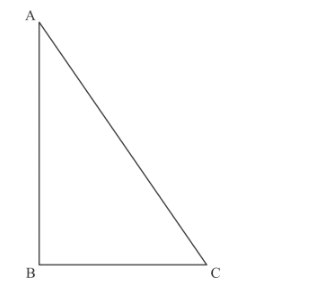A right angled triangle whose sides are 3 cm, 4 cm and 5 cm is revolved about the sides containing the right angle in two ways. Find the difference in volumes of the two cones so formed. Also, find their curved surfaces.
We consider the following figure as follows

Let the angle B is right angle and the sides of the triangle are AB = 4cm, BC = 3cm,
AC = 5cm.
When the triangle is revolved about the side AB, then the base-radius, height and slant height of the produced cone becomes BC, AB and AC respectively. Therefore, the volume of the produced cone is
$\mathrm{V}_{1}=\frac{1}{3} \pi \times \mathrm{BC}^{2} \times \mathrm{AB}$
$=\frac{1}{3} \pi \times(3)^{2} \times 4$
$=12 \pi$ cubic cm
In this case, the curved surface area of the cone is
$S_{1}=\pi \times \mathrm{BC} \times \mathrm{AC}$
$=\pi \times 3 \times 5$
$=15 \pi$ square $\mathrm{cm}$
When the triangle is revolved about the side BC, then the base-radius, height and slant height of the produced cone becomes AB, BC and AC respectively. Therefore, the volume of the produced cone is
$V_{2}=\frac{1}{3} \pi \times \mathrm{AB}^{2} \times \mathrm{BC}$
$=\frac{1}{3} \pi \times(4)^{2} \times 3$
$=16 \pi$ cubic cm
In this case, the curved surface area of the cone is
$S_{2}=\pi \times \mathrm{AB} \times \mathrm{AC}$
$=\pi \times 4 \times 5$
$=20 \pi$ square $\mathrm{cm}$
Therefore, the difference between the volumes of the two cones so formed is
$V_{2}-V_{1}=16 \pi-12 \pi$
$=4 \pi \mathrm{cm}^{3}$
Hence the difference between the volumes is $4 \pi \mathrm{cm}^{3}$
And surface areas are $15 \pi \mathrm{cm}^{2}$ and $20 \pi \mathrm{cm}^{2}$
